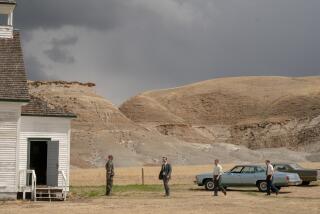Old Studio’s Silents Survive
- Share via
Between 1910 and 1917 the Thanhouser Film Corp. of New Rochelle, N.Y., produced more than 1,000 films, of which only 187 are known to exist today. Thanhouser launched several notable screen careers, including that of actor-turned-major-Hollywood-director James Cruze, and strived to maintain high production standards. Tonight at 8, Ned Thanhouser, grandson of company founders Edwin and Gertrude Thanhouser, will present at the Silent Movie two Thanhouser one-reelers and a 68-minute feature provided by the Library of Congress.
“Only in the Way” (1911) is a familiar 12-minute morality play with a clever psychological twist. When a wife gives her husband the ultimatum “Either your mother or I must leave this house!” she does not realize the impact sending the woman to a home for the aged will have on her own little lame daughter (spunky Marie Eline). It will be followed by “The Evidence of the Film” (1913), rediscovered only last year on the floor of the projection booth in a Superior, Mont., theater. Directed by Thanhouser and Lawrence Marston, it represents one of the earliest instances of a movie that depicts filmmaking itself. When a boy messenger (William Garwood) is accused of stealing $20,000 in bonds, he is saved by his sister (lovely Florence LaBadie, the studio’s biggest star). LaBadie plays a film cutter who comes across some footage of her little brother inadvertently walking into a location shot and being knocked down by the real-life villain, who quickly substitutes the letter containing the bonds with one filled with newspaper shreds. Both these one-reelers are made with skill and economy in authentic settings.
One of Thanhouser’s last productions before it and other film companies fell victim to a post-World War I depression, the 68-minute “The Unfortunate Marriage” is an ambitious adaptation of Wilkie Collins’ “The Woman in White.” LaBadie is effective in dual roles, that of a distraught mental-asylum escapee and her virtual double, an heiress whose fortune-hunting husband (Richard R. Neill) will play the uncanny resemblance between the two women to his own dastardly advantage. This melodrama was already pretty Faustian by 1917, but Thanhouser’s cast and crew, most notably cameraman William M. Zollinger, give it their best. The film, directed by Ernest C. Warde from Lloyd F. Lonergan’s script, has considerable style and brooding atmosphere amid handsome settings. “The Unfortunate Marriage” was released July 1, 1917, and LaBadie died at 29 the following October from injuries sustained in a car accident. (323) 655-2520.
*
Among films screening at the Egyptian Theater in the final weekend of the Los Angeles Latino International Film Festival is Brazilian filmmaker Luiz Villaca’s “Behind the Curtain” (Friday at 9 p.m.), a sparkling backstage comedy about how life and art collide. Denise Fraga plays a young actress, Helena, overwhelmed at the prospect of playing Lady Macbeth opposite a famous stage star, Sergio Montana (Luis Melo), middle-aged but still very much the dashing matinee idol, in an adaptation of “Macbeth.” A master of his craft, he expertly puts Helena at ease, freeing her to build her role. As opening night approaches, however, Alexandra (Ester Goes), Sergio’s stylish ex-wife and former acting partner, arrives to inform him that he’s been going through the motions for years. Helena also confronts his lack of passion. In a lesser film Sergio would be busy seducing Helena, but “Behind the Curtain” is not about romantic peccadilloes but rather an amusing and affectionate valentine to the theater’s eternal magic--and an acknowledgment of the strain it places on actors’ private lives. Villaca shares with George Cukor an ability to express on the screen an abiding love of the theater and of actors in all their folly and grandeur. (323) 469-9067.
*
At 7:30 p.m. Saturday, “The Power and the Glory” (1933) screens at the James Bridges Theater in Melnitz Hall as part of the UCLA Film and Television Archive’s 2000 Preservation Festival. Following that is another 1933 release, as obscure as the William K. Howard-Preston Sturges film is well-known and acclaimed. Directed by Phil Goldstone, “The Sin of Nora Moran,” like “Power,” also employs “narratage,” a studio publicity term describing the technique of using narration over flashbacks. Whereas “Power” is often called a proto-”Citizan Kane,” “Sin” is a resourceful screen adaptation of a stage melodrama in which narratage is a way of saving time and expense in relating a convoluted story by moving back and forth between several sets of flashbacks. This structure makes the film more cinematic and is its primary interest, since it’s otherwise a conventional tale of sacrificial love. A young woman (Zita Johann) with a past is prepared to die to protect the reputation of her married lover. Their story is related by an ambitious district attorney (Alan Dinehart) to his equally driven sister (Claire DuBrey), the governor’s wife, irate over her husband’s infidelity. Performances tend toward the theatrical, and it’s not specific about how the mistress’ past catches up with her so easily, but the film, while hardly outstanding, is not without interest. The film’s restoration, under the direction of archive preservationist Bob Gitt, is characteristically superb. (310) 206-FILM.
*
Artisan Entertainment is presenting at the Nuart starting Friday a one-week run of Joe Berlinger and Bruce Sinofsky’s award-winning, made-for-cable documentaries, the 150-minute “Paradise Lost: The Child Murders of Robin Hood Hills” and the 130-minute “Revelations: Paradise Lost 2,” investigating a horrifying 1993 triple murder in Tennessee and its aftermath. (310) 478-6379.
LACMA will present “Oskar Fischinger: A Centennial Retrospective,” composed of three programs of abstract animation of the German pioneer, Saturday and Sunday. Bing Theater, 5905 Wilshire Blvd., L.A.(323) 857-6010.
More to Read
The biggest entertainment stories
Get our big stories about Hollywood, film, television, music, arts, culture and more right in your inbox as soon as they publish.
You may occasionally receive promotional content from the Los Angeles Times.










